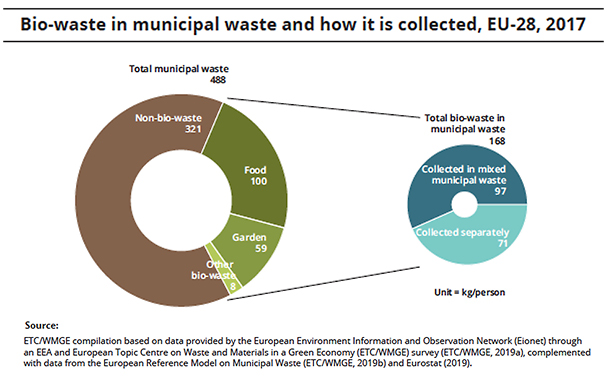The European Environment Agency released a new report this spring, Bio-Waste in Europe — Turning Challenges Into Opportunities, that provides an overview of biowaste prevention, generation, collection and treatment in Europe. The report is filled with statistics and case studies from a wide range of EU member countries. Its purpose, note the authors, is to “support countries by sharing experiences and best practices.” Biowaste (the organic fraction of MSW) is the largest component (34%) of all municipal waste in Europe. About 60% of this fraction is food waste. “Along the entire value chain, food waste amounts to about 173 kilograms (381 lbs) per European Union (EU) citizen per year or about 88 million metric tons (97 million tons), corresponding to about one-fifth of all food that is produced,” states the report. “Reducing the demand for food by preventing food waste can decrease the environmental impacts of producing, processing and transporting food. The benefits from reducing such upstream impacts are much higher than any environmental benefits from recycling food waste, which is still needed and important.”
Currently, composting is the dominant way of managing biowaste but anaerobic digestion with biogas production is increasing. The share of municipal waste composted and digested was 17% in 2018, up from 11% in 2004, according to the report: “This encompasses an installed capacity of 21 million metric tons (23 million tons) for the composting of biowaste and an additional 17 million metric tons (18.7 million tons) for anaerobic digestion. The actual treatment capacity is likely to be considerably higher, as a number of European countries did not provide data on the capacity of their treatment infrastructure.”
Key to processed biowaste being used as a source of high quality fertilizer and soil improver is collecting it separately at the source, while “keeping impurity levels low.” Notes the report, “about 50% of the municipal biowaste generated is collected separately in the countries that provided data (weighted average). The remaining 50% is collected with residual (mixed) waste. The separate collection rates vary from 80% or more in Austria and Slovenia to less than 10% in Bosnia-Herzegovina, Cyprus, North Macedonia, Portugal, Spain and Turkey, demonstrating that, at an individual country level, there remains ample room for improvement.”













